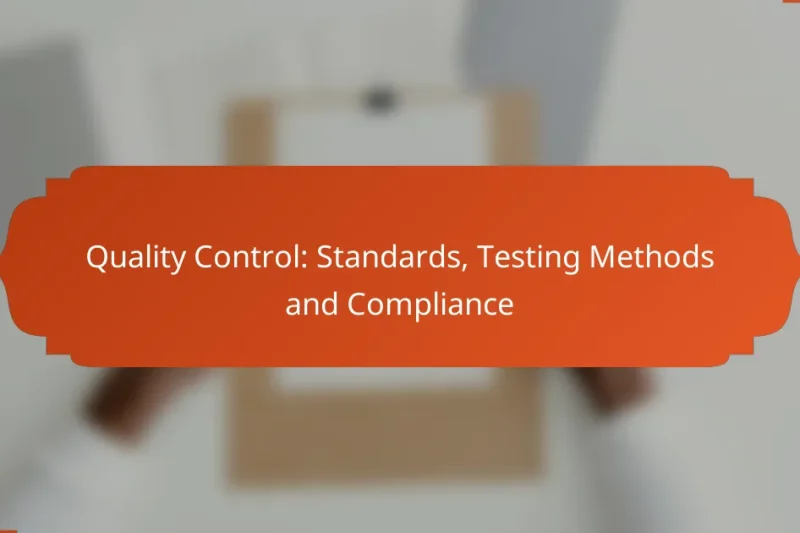Ethical practices in sourcing are crucial for e-commerce, as they ensure responsible procurement that enhances business … Ethical Practices: Sourcing Standards, Transparency and ComplianceRead more
Sourcing and Production for Custom Apparel
Sourcing and production for custom apparel involve navigating various options to find the best fit for your needs. From domestic manufacturers to overseas suppliers and print-on-demand services, each choice presents distinct advantages and challenges. Understanding key factors such as material quality, production timelines, and budget constraints is crucial for achieving the desired outcome in your custom apparel projects.
Quality Control: Standards, Testing Methods and Compliance
Quality control is essential in manufacturing, ensuring that products adhere to established standards for quality, safety, … Quality Control: Standards, Testing Methods and ComplianceRead more
Technology in Production: Automation, Efficiency and Innovation
Technology is revolutionizing production by introducing automation that significantly boosts efficiency and fosters innovation. With the … Technology in Production: Automation, Efficiency and InnovationRead more
Local vs Overseas Manufacturing: Cost, Quality and Turnaround
When considering manufacturing options, the choice between local and overseas production involves a careful evaluation of … Local vs Overseas Manufacturing: Cost, Quality and TurnaroundRead more
Production Timeline: Phases, Lead Times and Delivery Expectations
Understanding the production timeline is essential for managing expectations in any manufacturing process. It encompasses four … Production Timeline: Phases, Lead Times and Delivery ExpectationsRead more
Reliable Manufacturers: Selection Criteria, Quality Assurance and Communication
Choosing reliable manufacturers requires careful evaluation of their reputation, capabilities, and customer feedback to ensure alignment … Reliable Manufacturers: Selection Criteria, Quality Assurance and CommunicationRead more
Production Capacity: Scalability, Resource Management and Timelines
Production capacity is crucial for e-commerce success, requiring a focus on scalability, resource management, and adherence … Production Capacity: Scalability, Resource Management and TimelinesRead more
What are the best sourcing options for custom apparel in the USA?
The best sourcing options for custom apparel in the USA include domestic manufacturers, overseas suppliers, local artisans, online platforms like Alibaba, and print-on-demand services. Each option has unique advantages and considerations that can impact quality, cost, and turnaround time.
Domestic manufacturers
Domestic manufacturers are a reliable choice for custom apparel, offering shorter lead times and easier communication. They typically adhere to U.S. labor laws and quality standards, which can enhance product reliability.
When selecting a domestic manufacturer, consider their minimum order quantities (MOQs) and production capabilities. Many manufacturers can handle small to medium-sized orders, which is beneficial for startups or small businesses.
Overseas suppliers
Overseas suppliers often provide lower production costs, making them attractive for bulk orders. However, longer shipping times and potential customs duties can affect overall pricing and delivery schedules.
It’s crucial to vet overseas suppliers carefully. Look for those with good reviews and established reputations, and consider using third-party inspection services to ensure quality control before shipment.
Local artisans
Local artisans can offer unique, handcrafted apparel options that stand out in the market. This sourcing option is ideal for businesses looking to promote local craftsmanship and sustainability.
Collaborating with local artisans often allows for more customization and personal interaction, which can enhance the design process. However, be prepared for potentially higher costs and longer production times compared to mass manufacturers.
Online platforms like Alibaba
Online platforms like Alibaba connect businesses with a wide range of suppliers, primarily from Asia. These platforms can be useful for finding competitive pricing and diverse product options.
When using Alibaba, ensure to check supplier ratings and request samples before placing large orders. Understanding shipping terms and potential tariffs is also essential to avoid unexpected costs.
Print-on-demand services
Print-on-demand services allow businesses to create custom apparel without holding inventory. This model is ideal for startups or those testing new designs, as it minimizes financial risk.
These services typically integrate with e-commerce platforms, making it easy to manage orders. However, be mindful of the cost per item, which can be higher than bulk production, and the potential limitations in fabric choices and printing techniques.
How to choose the right production method for custom apparel?
Choosing the right production method for custom apparel depends on factors like design complexity, order volume, and budget. Each method has its strengths and weaknesses, making it essential to evaluate your specific needs before deciding.
Screen printing
Screen printing is a popular method for producing high-quality, vibrant designs on fabric. It works by creating a stencil (or screen) for each color in the design, allowing for multiple layers of ink to be applied. This method is cost-effective for larger orders, typically starting at around 25 pieces.
Consider screen printing for designs with few colors and when durability is a priority. However, it may not be the best choice for highly detailed images or small runs due to setup costs and time.
Direct-to-garment printing
Direct-to-garment (DTG) printing allows for detailed designs to be printed directly onto the fabric using specialized inkjet technology. This method is ideal for small orders or one-off pieces, as it requires no setup fees and can handle complex images easily.
While DTG offers high-quality prints, it may not be as durable as screen printing and can be more expensive per unit for larger orders. It’s best suited for designs with many colors or intricate details.
Embroidery
Embroidery involves stitching designs onto fabric using thread, creating a textured and professional look. This method is particularly effective for logos and simple designs, making it a popular choice for uniforms and promotional items.
Embroidery is durable and can withstand repeated washing, but it can be costly for intricate designs or larger pieces. It’s advisable to limit the number of colors and keep designs simple to control costs.
Sublimation printing
Sublimation printing is a dye transfer process that allows for vibrant, full-color designs to be infused into polyester fabrics. This method is excellent for all-over prints and offers a soft feel since the dye becomes part of the fabric.
However, sublimation works best on light-colored polyester materials and is not suitable for cotton fabrics. It’s ideal for sportswear and promotional apparel but may require a higher initial investment for equipment and materials.
What are the key factors to consider in custom apparel production?
Key factors in custom apparel production include material quality, production timelines, minimum order quantities, and cost per unit. Each of these elements significantly impacts the final product’s quality, delivery schedule, and overall profitability.
Material quality
Material quality is crucial for ensuring that the final apparel meets customer expectations and industry standards. High-quality fabrics can enhance durability, comfort, and appearance, while lower-quality materials may lead to dissatisfaction and returns.
When selecting materials, consider factors such as fabric weight, texture, and breathability. For example, cotton is popular for its softness and breathability, while polyester is favored for its durability and moisture-wicking properties.
Production timelines
Production timelines dictate how quickly you can deliver custom apparel to your clients. Understanding the lead times for sourcing materials, manufacturing, and shipping is essential for effective project management.
Typically, production timelines can range from a few weeks to several months, depending on the complexity of the design and the manufacturer’s capabilities. Establishing clear deadlines and maintaining open communication with suppliers can help mitigate delays.
Minimum order quantities
Minimum order quantities (MOQs) refer to the smallest number of units a manufacturer will produce for a given order. MOQs can vary significantly based on the supplier and the type of apparel being produced.
It’s common for MOQs to range from a few dozen to several hundred units. Understanding these requirements can help you plan your inventory and budget effectively, ensuring you don’t overcommit to unsold stock.
Cost per unit
Cost per unit is a critical factor that affects pricing strategy and profit margins in custom apparel production. This cost includes materials, labor, and overhead, and can vary based on order size and complexity.
Generally, larger orders tend to lower the cost per unit due to economies of scale. It’s advisable to obtain quotes from multiple suppliers to compare costs and ensure you are getting the best value for your investment.
How to ensure quality control in custom apparel sourcing?
To ensure quality control in custom apparel sourcing, implement a systematic approach that includes supplier audits, sample approvals, and robust quality assurance processes. These steps help maintain consistent standards and minimize defects in the final products.
Supplier audits
Supplier audits are essential for verifying that manufacturers meet your quality standards and ethical practices. Conduct regular on-site evaluations or third-party assessments to check for compliance with industry regulations and your specific requirements.
During an audit, focus on key areas such as production capabilities, labor conditions, and material sourcing. Establish a checklist that includes certifications like ISO or WRAP to streamline the evaluation process.
Sample approvals
Sample approvals are critical in the custom apparel production process, as they allow you to assess the quality and fit of the garments before mass production. Request samples of materials and finished products to evaluate their performance against your specifications.
When reviewing samples, consider factors like fabric durability, color accuracy, and stitching quality. Set clear criteria for approval and communicate these to your suppliers to avoid misunderstandings.
Quality assurance processes
Implementing quality assurance processes throughout production helps identify and rectify issues early. Establish checkpoints at various stages, such as pre-production, during manufacturing, and post-production inspections.
Utilize tools like statistical process control (SPC) to monitor production quality. Train your team to recognize common defects and establish corrective action plans to address any issues that arise, ensuring that the final products meet your standards.
What are the shipping and return policies for custom apparel?
Shipping and return policies for custom apparel vary by vendor but generally include specific guidelines on delivery times, costs, and conditions for returns. Understanding these policies is crucial for ensuring a smooth purchasing experience.
Shipping policies for custom apparel
Shipping policies typically outline the expected delivery timeframes, which can range from a few days to several weeks, depending on the complexity of the order and the shipping method chosen. Most vendors provide options for standard and expedited shipping, with costs varying accordingly.
It’s essential to check if the vendor offers free shipping on orders over a certain amount, as this can significantly reduce overall costs. Additionally, be aware of any potential customs fees if ordering internationally, as these can add to the total expense.
Return policies for custom apparel
Return policies for custom apparel are often stricter than for standard items, as personalized products may not be eligible for return unless they are defective or incorrect. Many companies allow returns within a specific timeframe, usually 14 to 30 days, provided the items are unused and in original packaging.
Before placing an order, review the vendor’s return policy carefully to understand the conditions under which returns are accepted. Some vendors may offer exchanges or store credit instead of refunds, which can affect your decision if you are unsure about sizing or design.
Key considerations for shipping and returns
When ordering custom apparel, consider the total cost of shipping and potential return fees. Always verify the vendor’s policies on custom orders, as these can differ significantly from standard merchandise. Keep in mind that clear communication with the vendor can help resolve any issues regarding shipping delays or return eligibility.
To avoid common pitfalls, double-check your order details before finalizing the purchase, including sizes, colors, and any customizations. This diligence can help minimize the likelihood of needing to return items later.






